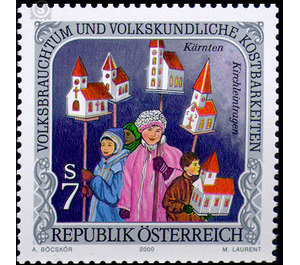folklore - Austria / II. Republic of Austria 2000 - 7 Shilling
Theme: Architecture
| Country | Austria / II. Republic of Austria |
| Issue Date | 2000 |
| Face Value | 7.00 |
| Printing Type | combination printing |
| Stamp Type | Commemorative |
| Item Type | Stamp |
| Chronological Issue Number | 1645 |
| Chronological Chapter | OOS-OE2 |
| SID | 998193 |
| In 61 Wishlists | |
The custom of introducing the church in Bad Eisenkappel, the southernmost, located in a basin spa and border town of Austria, recalls the folklore of the practice of floodlit light. Days and weeks before February 1, the children in the elementary school of Bad Eisenkappel tinker with enthusiasm on the churches made of white and colored paper. On the eve of Mariä Lichtmess (2 February), the tinkered paper churches are mounted on support poles and carried to the bridge at Hagenegg Castle. Arrived at the bridge, the participants carefully pass their churches to the waters of the sometimes snow-covered and icy Vellach. The "Light Churches" dance then agile on the waves of the river until they tip over and slowly lose their light. The time of the introduction of the custom "Kirchleintragen" can only be assumed. Allegedly, a vow after a flood in the 12th century should form the root of the procession. The reason for this procession was, according to the legend, a storm and a flood disaster. After the main square, the houses and the parish church had been flooded by the flood-leading Vellach and only the pilgrimage church Maria Dorn over the place defy the floods, the Eisenkappler, who had sought refuge in the church, vowed a procession annually to thank for the salvation in which they carry enlightened churches to the Vellach and hand them over to the inconspicuous river.


